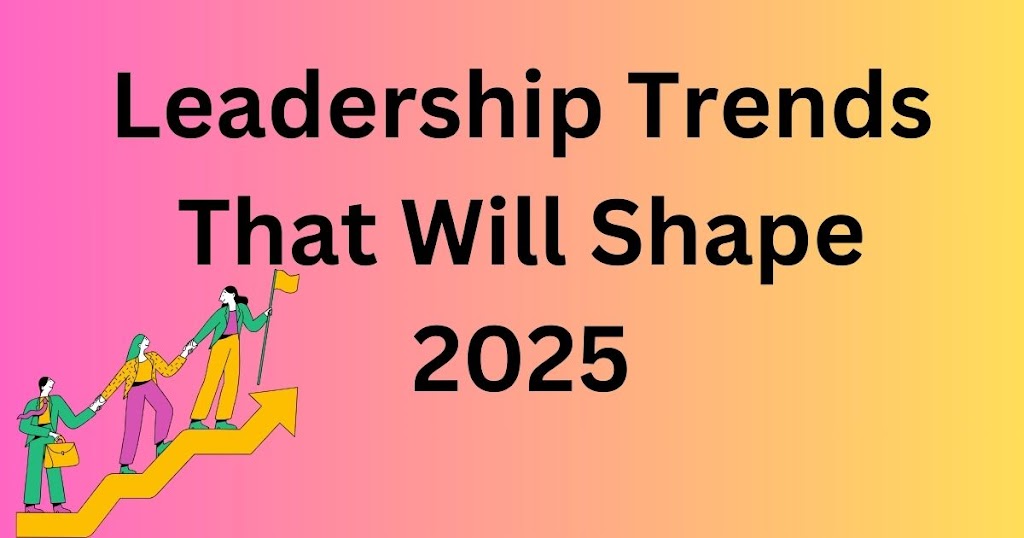Have you seen how leadership trends that will shape 2025 are changing as we get closer to the new year? The business world is moving quickly, influenced by new technologies, changing work habits, and what people expect from leaders. For leaders to succeed in this changing environment, it’s important to recognize these trends and adjust their styles. By understanding these shifts, leaders can connect better with their teams and inspire everyone to succeed.
Let’s examine how leaders can use these upcoming trends to make a positive impact in 2025 and beyond.
1. The Rise of Agentic AI: Balancing Automation and Innovation
Agentic AI refers to the intelligence that can perform tasks autonomously, solve problems, and make decisions. This will be a game-changer in the way organizations operate. Instead of merely automating routine tasks, Agentic AI will handle complex decision-making processes, freeing up time for leaders to focus on strategy and innovation.
Real-World Example: Companies like IBM are already using AI-powered tools like Watson to automate tasks and enhance decision-making in the healthcare and finance sectors.
Why it matters: AI can drastically improve operational efficiency, increase productivity, and reduce human error. However, leaders must ensure that AI is integrated to complement human creativity rather than replace it.
Challenges: While AI presents many advantages, there are potential risks, such as job displacement and over-reliance on technology. Leaders must foster a balance between AI and human intelligence.
How Leaders Can Prepare:
- Invest in AI training: Help teams understand AI tools and how they can complement human work.
- Encourage AI-human collaboration: Create a work environment where AI supports human creativity and decision-making.
- Maintain a focus on ethics: Implement AI with strong ethical guidelines to avoid bias and ensure fair decision-making.
2. A Human-Centric Approach to Technology
As technology advances, the focus in 2025 will shift toward human-centered innovation. Rather than automating everything, AI and technology should be used to empower human skills like creativity, empathy, and complex problem-solving.
Why it matters: Human ingenuity is irreplaceable, and the most successful organizations will use technology to enhance the unique qualities of their employees.
By creating environments where technology and people work symbiotically, leaders can drive innovation and foster greater employee engagement.
Challenges: The challenge lies in ensuring technology is implemented in a way that doesn’t dehumanize the workplace or reduce employee autonomy.
How Leaders Can Prepare:
- Invest in AI tools that support human work: Use technology like Asana and Slack for task management and communication, while allowing employees to retain creative control.
- Foster collaboration between humans and AI: Train employees to use AI as a collaborative tool, not as a replacement for human thought.
3. The Boom in Fractional Leadership
Fractional leadership is on the rise. In this model, experienced executives are hired on a part-time basis to provide specialized expertise on a project or during periods of transition.
This trend is helping businesses access top-tier leadership without the burden of full-time salaries.
Real-World Example: Companies like On Deck and Toptal have embraced fractional leadership, which allows them to hire specialized leaders in areas like operations, finance, and marketing on demand, helping them scale more efficiently.
Why it matters: Fractional leadership offers small and mid-sized businesses access to experienced leadership that would otherwise be out of reach. This flexible model helps organizations remain agile and adapt quickly to changing market conditions.
Challenges: Fractional leaders may face challenges integrating into the company culture or aligning their work with long-term strategic goals. Communication gaps and lack of continuity can also be risks.
How Leaders Can Prepare:
- Embrace flexibility: Create an organizational structure that accommodates fractional roles.
- Ensure clear onboarding: Provide detailed onboarding and clear expectations to fractional executives.
Leverage networks: Build a network of fractional leaders that can be called upon when needed, ensuring that expertise is available for critical projects.
4. Accommodating Neurodiversity in the Workplace
The focus on neurodiversity is gaining momentum, as organizations begin to recognize the value of employing neuro divergent individuals (such as those with autism, ADHD, or dyslexia). By making simple accommodations, leaders can unlock these individuals’ unique strength include creativity, problem-solving, and attention to detail.
Real-World Example: Companies like Microsoft and SAP have introduced neurodiversity hiring programs, with Microsoft focusing on bringing neuro divergent individuals into the workforce and providing customized accommodations such as flexible schedules and mentorship.
Why it matters: Neuro divergent employees bring a diverse range of perspectives, which can drive innovation and improve team performance. Creating an inclusive workplace that values all forms of cognitive diversity leads to greater employee satisfaction and retention.
Challenges: Leaders may encounter challenges in making the workplace truly inclusive, including the need for specialized training and resources to help neurodivergent employees thrive.
How Leaders Can Prepare:
- Implement tailored accommodations: Offer flexible working hours, written communication, and structured environments.
- Foster awareness: Train managers to recognize and support neuro diverse needs, ensuring inclusivity in the hiring and onboarding process.
Celebrate neurodiversity: Create a culture that values diverse ways of thinking and problem-solving.
5. Renewed Focus on Culture and Wellbeing
In 2025, the emphasis on organizational culture and employee well-being will be more important than ever. Leaders will need to create a workplace that fosters flexibility, mental health, and continuous development.
Why it matters: Employees who feel valued and supported are more likely to be engaged, productive, and loyal. A positive organizational culture drives both employee satisfaction and company performance. In a time of economic uncertainty and shifting work norms, strong culture and well-being are critical for retaining top talent.
Related read: Adapting Leadership Styles in the Digital Age
Challenges: Maintaining a healthy work culture in hybrid or remote settings can be difficult. Leaders must ensure that employees feel connected, even when working remotely.
How Leaders Can Prepare:
- Prioritize wellbeing: Provide mental health resources and promote work-life balance.
- Encourage flexibility: Implement flexible working policies that accommodate the needs of your employees.
- Upskill middle managers: Equip managers with the tools to foster culture and well-being within teams.

Leadership Trends That Will Shape 2025
6. Navigating the Leadership Pipeline Crisis
Why it matters: Without a strong leadership pipeline, organizations risk losing stability, innovation, and competitiveness. Addressing the leadership pipeline crisis is crucial for long-term success.
Challenges: Emerging talent may feel unprepared for the pressure of traditional leadership roles or may shy away from leadership positions altogether due to stress and burnout.
How Leaders Can Prepare:
- Redefine leadership: Shift from traditional top-down leadership models to more collaborative, supportive approaches that emphasize wellbeing.
- Provide mentorship: Offer mentoring and coaching opportunities for emerging leaders.
- Build a sustainable leadership model: Create opportunities for emerging leaders to grow and develop, ensuring they have the tools and support they need to succeed.
Practical Steps for Leaders in 2025
To navigate these trends effectively, leaders must embrace the following best practices:
- Build Trust: Foster transparency, empathy, and open communication.
- Leverage Technology: Use tools like Slack, Zoom, and Trello to enhance collaboration and communication across teams.
- Encourage Growth: Provide challenging assignments and continuous learning opportunities for your teams.
- Promote Safety: Create environments where employees feel safe to innovate, make mistakes, and take risks.
- Model Wellbeing: Demonstrate healthy work-life boundaries to inspire your team and prevent burnout.
What Organizations Must Do
Organizations must support leaders in embracing these trends. Key steps include:
- Offer personalized development plans: Help leaders close skill gaps and grow into future roles.
- Create robust support systems: Provide mentorship, resources, and tools to foster leadership growth.
- Recognize and reward leaders: Acknowledge leaders who build trust, promote innovation, and prioritize employee wellbeing.
By staying ahead of these leadership trends, organizations can build resilient, innovative teams ready to face the challenges of 2025 and beyond. The future belongs to those who prioritize human connection, innovation, and ethical leadership, creating a workplace where everyone can thrive.
Conclusion
FAQs
1. What Is Agentic AI in Leadership?
Agentic AI refers to AI systems capable of performing tasks autonomously and making decisions. In leadership, it enhances efficiency by automating routine tasks, allowing leaders to focus on strategy and innovation.
2. How Does Neurodiversity Benefit Workplace Leadership?
Neurodiversity in the workplace brings diverse cognitive abilities, such as creativity and problem-solving skills. Embracing neurodiverse employees can drive innovation and improve team performance, leading to a more inclusive and effective work environment.
3. What Is Fractional Leadership and Why Is It Growing?
Fractional leadership involves hiring experienced executives on a part-time basis for specific projects or during transitions. This flexible model helps organizations access top leadership talent without the cost of full-time salaries, allowing for quicker adaptation to changing market needs.
4. How Can Leaders Improve Employee Wellbeing in 2025?
Leaders can improve employee well-being by offering mental health resources, promoting work-life balance, and creating flexible work policies. Prioritizing well-being helps enhance employee engagement, retention, and overall organizational performance.
5. How Can AI and Humans Collaborate Effectively in Leadership?
Effective AI-human collaboration in leadership involves using AI tools to support, not replace, human creativity and decision-making. Leaders should train teams to leverage AI for data analysis and routine tasks while focusing on strategy, innovation, and empathy.


